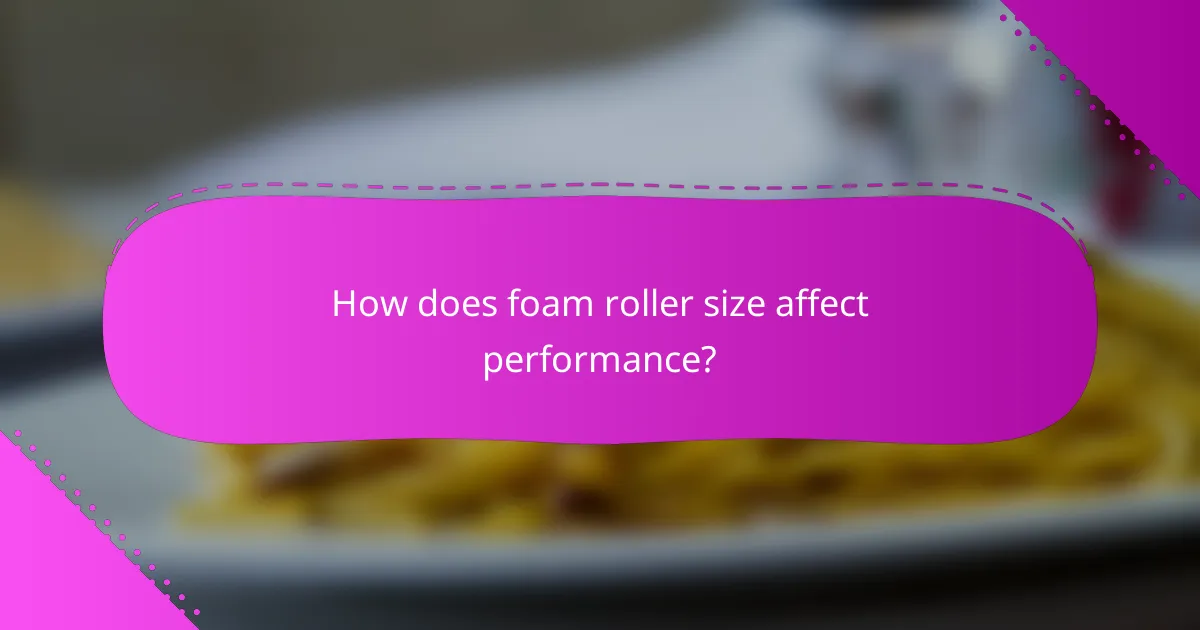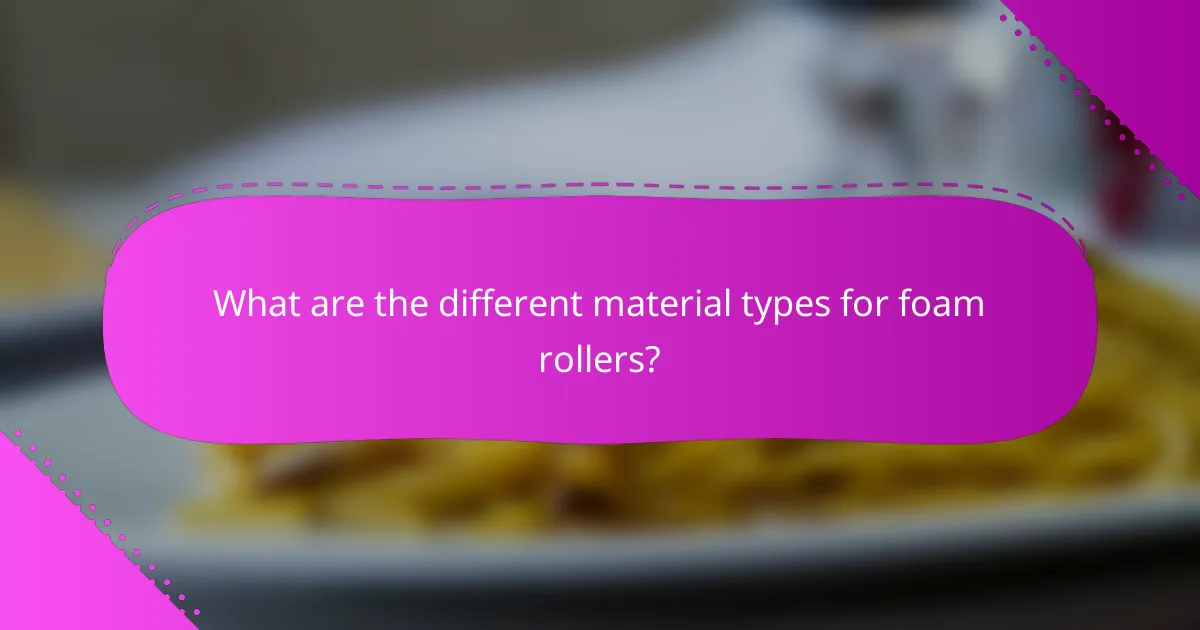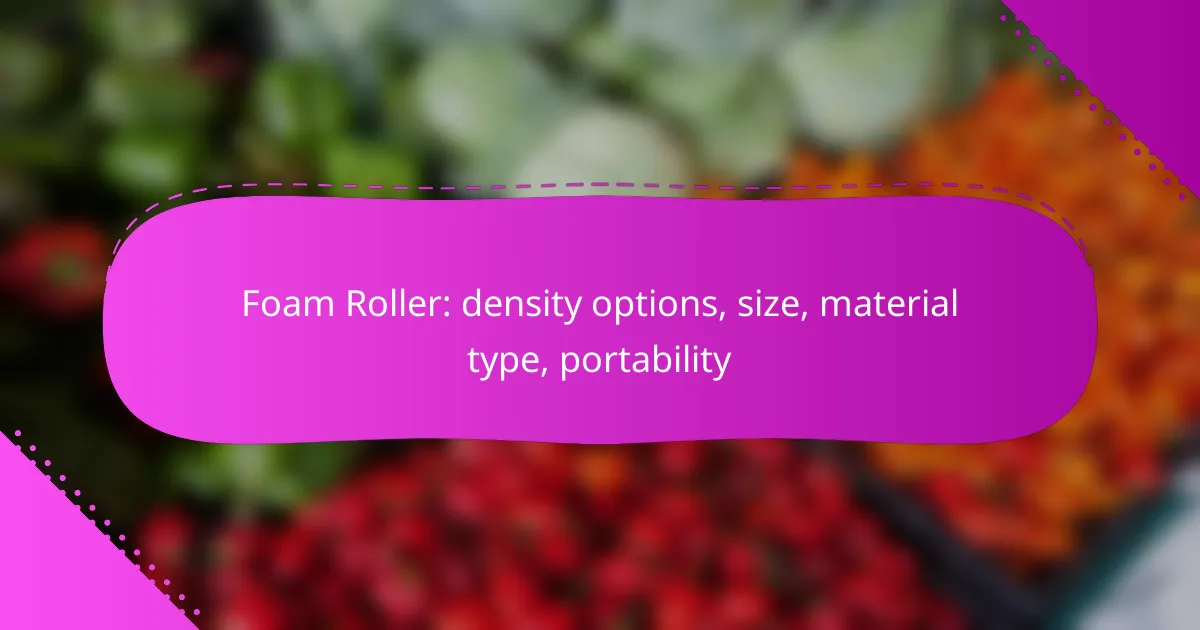Foam rollers are essential tools for muscle recovery, available in a variety of densities, sizes, and materials to suit individual needs. Selecting the appropriate density is vital for effective recovery and injury prevention, while the size influences targeting specific muscle groups. Made from materials like EVA foam, polyethylene, and rubber, each foam roller offers unique benefits in terms of durability and grip, ensuring users can find the perfect match for their workout routine.

What are the best foam roller density options in Australia?
In Australia, the best foam roller density options range from soft to high density, catering to various user needs and experience levels. Choosing the right density is crucial for effective muscle recovery and injury prevention.
Soft density for beginners
Soft density foam rollers are ideal for beginners or those with sensitive muscles. They provide a gentle massage, helping to ease tension without causing discomfort. These rollers are particularly useful for individuals new to foam rolling or recovering from injuries.
When selecting a soft density roller, look for options that are around 10-15 cm in diameter. This size allows for easier handling and better control during use.
Medium density for general use
Medium density foam rollers are versatile and suitable for most users, including athletes and fitness enthusiasts. They strike a balance between comfort and effectiveness, providing adequate pressure to release muscle knots while remaining manageable for daily use.
These rollers typically measure between 15-20 cm in diameter and are a great choice for those who want to incorporate foam rolling into their regular fitness routine. They can be used on various muscle groups, making them a practical addition to any gym bag.
High density for advanced users
High density foam rollers are designed for advanced users who require deeper tissue massage. They are firmer and can effectively target stubborn knots and tight areas, making them suitable for experienced athletes or those with chronic muscle tension.
When using a high density roller, it’s essential to apply pressure gradually to avoid excessive discomfort. These rollers are often around 15-20 cm in diameter, providing a solid surface for intense muscle work. Be cautious if you are new to foam rolling, as these can be quite painful if not used correctly.

How does foam roller size affect performance?
The size of a foam roller significantly impacts its performance and suitability for various exercises. Choosing the right size can enhance your ability to target specific muscle groups, improve stability, and increase overall effectiveness during recovery or workouts.
Standard size for full-body use
A standard foam roller typically measures around 36 inches in length and 6 inches in diameter. This size is ideal for full-body use, allowing you to roll out larger muscle groups like the back, thighs, and calves effectively. It provides a balanced surface area for various techniques, including myofascial release and stretching.
When selecting a standard foam roller, consider your height and body type. Taller individuals may benefit from longer rollers to accommodate their range of motion, while those with a more compact frame might find a standard size sufficient for their needs.
Short size for targeted areas
Short foam rollers, usually around 12 to 18 inches long, are designed for targeting specific muscle groups. These compact rollers are excellent for areas like the arms, feet, and neck, where precision is essential. Their smaller size allows for easier maneuverability and control during use.
When using a short foam roller, focus on one muscle group at a time to maximize effectiveness. This targeted approach can help alleviate tension and soreness in localized areas, making it a valuable tool for athletes and fitness enthusiasts alike.
Long size for stability and support
Long foam rollers, often exceeding 36 inches, provide added stability and support during exercises. They are particularly beneficial for balance training and can be used for various stretching and strengthening routines. The extended length allows for multiple users or larger movements without losing stability.
Using a long foam roller can enhance your workout by incorporating it into exercises like planks or bridges, where additional support is beneficial. Ensure you have enough space to accommodate the longer size, especially in smaller workout areas.

What are the different material types for foam rollers?
Foam rollers are made from various materials, each offering unique benefits and characteristics. The most common types include EVA foam, polyethylene, and rubber, which cater to different preferences for durability, weight, and grip.
EVA foam for durability
EVA foam is known for its durability and resilience, making it a popular choice for foam rollers. This material can withstand regular use without losing its shape, providing consistent support during workouts and recovery sessions.
When selecting an EVA foam roller, look for options that have a density range suitable for your needs. Higher density rollers tend to offer more firmness, which can be beneficial for deeper tissue work, while lower density options are better for beginners or those with sensitivity.
Polyethylene for lightweight options
Polyethylene foam rollers are favored for their lightweight nature, making them easy to transport and store. This type of foam is often softer than EVA, providing a gentler experience for users who may be new to foam rolling.
Consider polyethylene rollers if you plan to travel or need a roller for light use. They are typically less expensive than their EVA counterparts, but may not offer the same level of durability over time.
Rubber for enhanced grip
Rubber foam rollers provide enhanced grip, making them ideal for users who want stability during their rolling sessions. The textured surface of rubber helps prevent slipping, allowing for better control while performing various exercises.
These rollers are particularly useful for athletes who engage in dynamic movements or require a firm grip for balance. However, they may be heavier than foam options, so consider your portability needs when choosing a rubber roller.

How portable are foam rollers for travel?
Foam rollers can be quite portable, making them suitable for travel. Their design and material choices often cater to easy packing and transport, allowing users to maintain their fitness routines on the go.
Compact designs for easy packing
Many foam rollers are designed in compact sizes, which makes them easier to fit into luggage or gym bags. Look for models that are around 12 to 18 inches long, as they offer a balance between usability and portability.
Some brands even offer collapsible or foldable options, which can further reduce space requirements. These compact designs ensure that you can take your roller anywhere without sacrificing too much room in your bag.
Inflatable options for maximum portability
Inflatable foam rollers are an excellent choice for travelers seeking maximum portability. When deflated, they take up minimal space, making them easy to pack in any travel bag.
These rollers can be inflated quickly, allowing for immediate use upon arrival. However, ensure that the material is durable enough to withstand regular use, as some inflatable models may be less robust than traditional foam rollers.
Lightweight materials for convenience
Foam rollers made from lightweight materials, such as EVA foam or polyethylene, enhance portability. These materials are not only light but also provide adequate support for muscle recovery.
When selecting a roller, consider its weight; options typically range from about 0.5 to 2 kilograms. A lighter roller is easier to carry, making it a practical choice for those who frequently travel.

What criteria should you consider when choosing a foam roller?
When selecting a foam roller, consider density, size, material type, and portability. These factors significantly influence your experience and effectiveness in muscle recovery and pain relief.
Density based on experience level
The density of a foam roller affects how it interacts with your muscles. Beginners often benefit from softer rollers, which provide a gentler massage, while more experienced users may prefer firmer options for deeper tissue work.
A common approach is to start with a medium-density roller and adjust based on comfort and effectiveness. For those with specific muscle tension or soreness, a high-density roller can deliver more targeted relief.
Size according to intended use
Foam rollers come in various sizes, typically ranging from 30 to 90 centimeters in length. A shorter roller is more portable and easier to use on specific muscle groups, while a longer roller can cover larger areas, making it ideal for full-body use.
For travel, a compact roller is advantageous, while a standard size is better for home use. Consider your primary activities; for example, athletes may prefer longer rollers for comprehensive stretching and recovery.
Material for durability and comfort
Foam rollers are made from different materials, including EVA foam, polyethylene, and high-density foam. EVA foam is lightweight and offers a good balance of comfort and durability, making it a popular choice for general use.
High-density foam rollers are more durable and provide a firmer massage, suitable for advanced users. When selecting a roller, consider how often you will use it and whether you need a roller that withstands frequent use without losing its shape.

What are the emerging trends in foam roller technology?
Emerging trends in foam roller technology focus on enhanced materials, varying densities, and innovative designs that improve user experience and effectiveness. These advancements aim to cater to diverse needs, from portability to specific muscle recovery requirements.
Density options
Foam rollers come in various densities, which affect their firmness and the intensity of the massage they provide. Softer rollers are typically better for beginners or those with sensitive muscles, while firmer options are ideal for experienced users seeking deeper tissue release. A common range for density levels includes soft, medium, and hard, allowing users to choose based on their comfort and recovery goals.
When selecting a density, consider your fitness level and the areas you wish to target. For instance, a firmer roller can be beneficial for larger muscle groups like the thighs, while a softer option may be more suitable for delicate areas like the lower back.
Size
Foam rollers vary in size, typically ranging from 30 cm to 90 cm in length. Shorter rollers are more portable and easier to store, making them suitable for travel or small spaces. Longer rollers provide a larger surface area, allowing for more versatile use across different muscle groups.
When choosing a size, think about your intended use. A longer roller is better for full-body rolling, while a shorter one can be more convenient for targeted areas or when on the go.
Material type
Foam rollers are made from various materials, including EVA foam, polyethylene, and high-density foam. Each material offers different levels of durability, comfort, and effectiveness. EVA foam is lightweight and commonly used for softer rollers, while high-density foam provides a firmer feel and is more durable for frequent use.
Consider the material based on your needs. If you plan to use the roller regularly, investing in a high-density option may yield better long-term results. For occasional use, a softer material might suffice.
Portability
Portability is a significant trend in foam roller design, with many models now being lightweight and compact. Some rollers are designed to be collapsible or come with carrying cases, making them easy to transport for workouts or travel. This trend caters to fitness enthusiasts who want to maintain their recovery routine on the go.
When assessing portability, look for features such as weight and size. A roller that fits easily into a gym bag or suitcase can enhance your ability to stay consistent with your recovery practices, no matter where you are.
